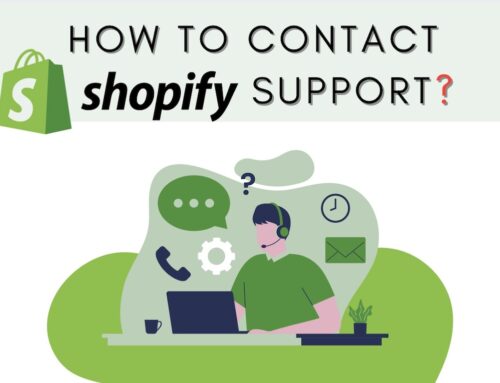Shopify currently has a few options for businesses with basic B2B wholesale needs, but it fails to provide a comprehensive solution for more complex wholesale needs. So how to set up Shopify B2B wholesale stores?
Will Shopify invest more aggressively in wholesale in 2024, and will they become a true B2B competitor? Or are there other more efficient options?
Let’s find out in this article!
Contents
Uncover the B2B eCommerce Market’s Must-Haves
Although B2B eCommerce sales were impacted hard by Covid-19 last year, it’s evident that B2B purchasers will conduct significantly less shopping via phone, fax, and other offline methods—and far more online, according to the B2B Ecommerce Market Report in 2021.
As the global pandemic last spring began to shut down traditional sales channels like distribution branches, B2B sellers saw a significant surge in demand for digital commerce sales channels from B2B buyers in 2020.
B2B eCommerce sales primarily increased by 10% to $1.39 trillion in 2021, up from $1.26 trillion in 2019. B2B eCommerce sales climbed by 11.8% to $2.19 trillion in 2020 combined with e-procurement sales.
Moreover, according to a January 2021 survey of 110 B2B sellers of varying sizes, 62% of enterprises reported an increase in eCommerce sales of at least 25% last year, with 12% reporting an increase of more than 75%.
As a result, wholesale is an excellent marketplace for any Shopify business. Regardless of the size or what item you are selling, it would be best to consider how to set up B2B and wholesale stores on Shopify.
Read More: Shopify Wholesale and B2B: Tips To Prepare for Holiday Sales.
Shopify B2B Wholesale Stores vs Others Differences
At first glance, the distinction between Shopify B2B and B2C appears trivial. Externally, online stores frequently resemble each other and share many features.
The disparity in business procedures and functioning, on the other hand, is systemic. They differ significantly in the B2B market compared to the B2C segment. The type of client, the audience with which the company works, and the personnel separate Shopify B2B commerce from B2C commerce. Besides, in B2C transactions, rates are cheaper, the sales cycle is shorter and more accessible, and the number of decision-makers is lower than in B2B transactions.
You can refer to some examples of Shopify B2B wholesale stores such as Beard & Blade (Beauty and cosmetics store), Laird Superfood (Fitness and nutrition store), Death Wish Coffee (Food and Beverage store); etc.
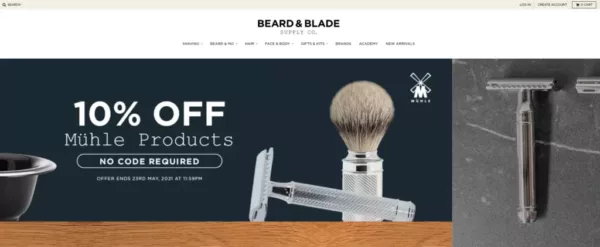
Beard & Blade expanded its product range and customer service by using a Shopify B2B website that provides a seamless client experience.
See more examples of very successful Shopify B2B stores at Shopify B2B Examples: Successful Websites To Be Followed.
However, you do not have to choose only one of these two business forms. Ideally, many brands choose to be combined stores, which sell to their customers directly and wholesale to retailers and distributors.
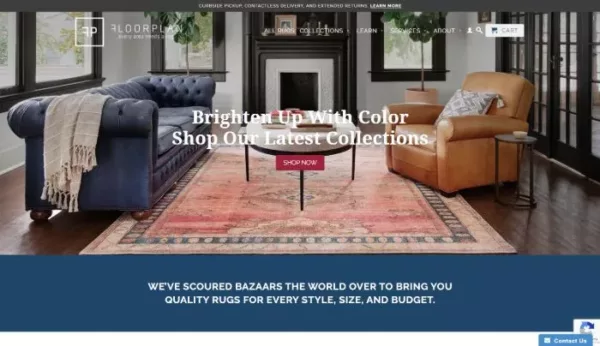 The floorplan is a wholesale and retail store that serves many consumers on both fronts.
The floorplan is a wholesale and retail store that serves many consumers on both fronts.
In addition, a common point to design Shopify B2B wholesale stores while still serving individual customers is an intelligent pricing strategy. If you are worried that your store will become cluttered with different prices for each customer, B2B Login/Lock & Hide Price is the perfect choice for you.
Specifically, the app will restrict private pages, hide price, hide product, secret shop, personal link, subscribe to access pages are all at your fingertips, especially if your website is for Wholesale B2B or members only.
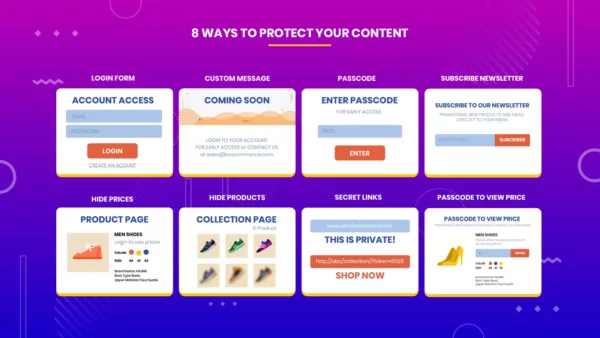
B2B Login/Lock & Hide Price offers you up to 8 ways to secure your pricing strategy.
🎁 DOWNLOAD NOW: B2B LOGIN/LOCK & HIDE PRICE
How To Set Up Shopify B2B Wholesale Store
Whether you’re a B2B company seeking an eCommerce solution or an existing eCommerce site looking to bring on your first wholesale customers, there are several ways Shopify can power your trade store. We have compiled four ways to design a Shopify B2B wholesale store below.
| Code System | Utilize A Third-Party App | Upgrade To Shopify Plus Plan | Shopify’s Handshake Marketplace | |
| Cost | Cheap | $25-$100/month | $2,000/month | Free to join (If you’re making your first sale or your 50th, there are no commissions) |
| Benefit | Cheap | Complete wholesale solution at an affordable price | Ideal for hosting and scalability | Have a broad reach and a minimal entry cost and effort |
| Drawback | It doesn’t appear very professional and lacks features. | None | It is too expensive. There isn’t much room for customization when it comes to page design. | It does not provide a strong brand experience and only available in the US. |
| Suitable For | Small businesses | All kinds of businesses | Large businesses | Small & medium enterprises in the US |
Set Up Shopify B2B Wholesale Store By Using Code System
Using Shopify’s offer code system is an excellent place to start for small businesses struggling to find out how to set up Shopify B2B wholesale stores. You can set up permanent percentage discounts for your wholesale customers in the same way you would generally set up a discount code for your newest offer.
However, this isn’t the best approach, and it’s not suggested for larger organizations because it doesn’t appear very professional. Wholesale customers will, of course, be required to input a discount code each time they make a purchase. Still, in my experience, buyers are accommodating to smaller firms and are perfectly ready to operate in this manner.
The discount codes you produce for this might be for individual consumers or a group of customers for each percentage discount. Managing many clients might get challenging over time, but using customer groups surely helps.
It is also critical to consider the payment methods you give your consumers and ensure they are suitable for trade customers. Indeed, you should create a manual payment method called ‘Wholesale Order,’ offered during checkout and eliminate the need for Shopify B2B customers to provide their payment credentials.
Pros:
- Cheap
- Suitable for small businesses
Cons:
- Every time a trade customer checks out from your store, they will be required to submit an offer code.
- Only percentage discounts are available for pricing.
- The same percent discount must be applied to all products, and this cannot be adjusted by-product or collection.
- Managing a large number of consumers gets difficult with this method over time.
- While browsing the store, the customer will not see their prices. These will be available only once they enter their discount coupon at the checkout.
Utilize A Third-Party App
A third-party app is an excellent answer for all firms on how to set up Shopify B2B wholesale stores. However, keeping and updating pricing lists and clients might become problematic when your business grows. Some easy actions, such as adding new products to your store, become more complicated because you must also enter prices into the application.
#1 B2B/Wholesale Solution
The finest software for this now on the market is the B2B/Wholesale Solution app provided by BSS Shopify Commerce, which can solve all the problems and become a robust tool for store owners.
The main advantages of this technique above simply employing discount codes are that the consumer does not have to submit a discount code when they check out. They may also view these costs as they peruse the store, making for a more enjoyable purchasing experience.
Moreover, you are free to create custom Shopify B2B wholesale registrations, which help separate customers from the start. Plus, this feature can add a tag for approved customers to manage easily later.
B2B/Wholesale Solution allows you to set up custom product pricing based on customers/customer tags.
Another significant benefit of this solution is its freedom for pricing for your clients. You may customize not just whole pricing lists for your trade customers but also individual price lists, allowing you to tune your prices to a granular level. The ability to provide tiered pricing/quantity breaks as an optional extra for consumers purchasing large quantities of certain products can also be added.

Furthermore, B2B/Wholesale Solution includes a feature to include/exclude tax and automatically VAT exempt for qualified customers. If your Shopify B2B wholesale store is headquartered in the European Union and your company is VAT-registered, you should not charge VAT to wholesale customers from other EU countries.

This feature helps merchants automatically exempt tax for customers instead of doing it manually.
🎁 DOWNLOAD NOW: B2B/WHOLESALE SOLUTION
#2 B2B Customer Portal/ Net Terms
What’s more, taking advantage of a third-party app is the unlimited number of features you can add. That means you can ultimately use many applications simultaneously, and a perfect choice among them is B2B Customer Portal/ Net Terms.
This app helps you enhance the shopping experience with the Quick Orders/ Bulk Order feature. Specifically, B2B customers can order from the whole product portfolio on a single page. They can easily add numerous things to their cart or checkout directly from the Quick Order page.
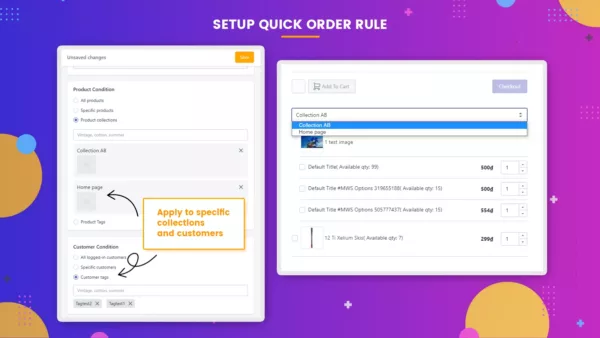
Besides, two other notable features include Net Terms and Bundle Kit. The net Terms allow select clients to create an unpaid order directly from their shopping cart. Customers must pay within the specified time frame (e.g., Net15/30/45/60/90).
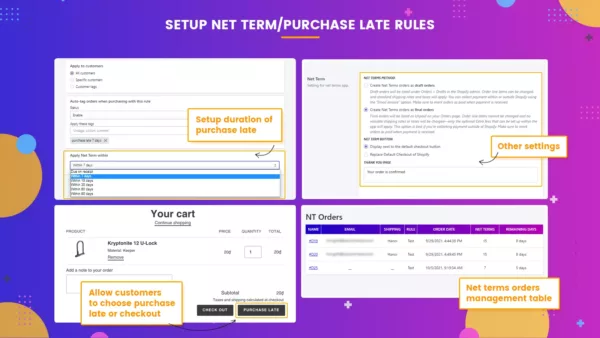
While Bundle Kit allows store owners to swiftly assemble product bundle kits in your store with no duplicated products or variants, sync combined products, and fulfill orders. The two features are all needed to how to set up Shopify B2B wholesale stores.
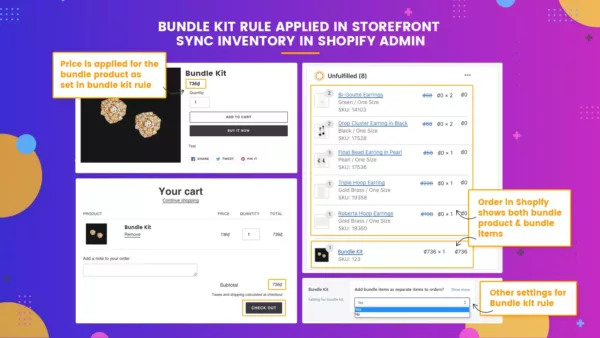
Bundle Kit rule applied in storefront sync inventory in Shopify admin.
🎁 CHECK IT OUT: B2B CUSTOMER PORTAL/ NET TERMS
Pros:
- Shopify’s partners have stepped in to address the market demand for wholesale demands without a complete solution. =>
- Complete solution with full features, no extra cost or effort
- Easy to use
- Mobile-friendly
- Improve UX
- Secure pricing strategy
Cons:
- If you have problems with the setup, the support team is ready to help you 24/7 => Almost eliminates all the limitations of other methods.
Upgrade To Shopify Plus Plan
When Shopify Plus was created, they had only one target customer in mind: large-scale enterprises wishing to migrate from traditional, offline B2B to modern, online B2B. To put it bluntly, Shopify Plus isn’t interested in you if you’re a new B2B company trying to start selling from the ground up due to the staggering $2,000/month price tag of Shopify Plus.

On the other hand, a wholesale website is provided as part of a Shopify Plus membership, so businesses with a current Shopify Plus plan may easily add a wholesale store to their offering.
With Shopify Plus, you can create custom pricing, payment methods and personalize the client experience. Because this is Shopify’s solution, everything is simple to administer, understand, and maintain, even if you have thousands of wholesale customers. You can even use Shopify Flow, which is included with Shopify Plus, to automate some of your back-office procedures and make life easier for your team.
Additionally, Shopify’s other three options, Basic Shopify, Shopify, and Advanced Shopify, don’t have the same features as Shopify Plus. However, if you are wondering how to set up Shopify B2B wholesale stores, they’re still ideal for building a small-scale B2B store with the ability to grow.
In general, Shopify Plus is a relatively expensive option to design wholesale Shopify stores. Meanwhile, you can ultimately use the 2nd way – utilize a third-party app to save costs but still ensure a perfect wholesale solution to help ensure customers’ shopping experience.
Pros:
- It’s ideal for hosting and scalability.
- Excellent and personalized service
- Processes in automotive
Cons:
- There isn’t much room for customization when it comes to page design.
- According to a 2015 Huff Industrial Marketing Study, 37% of B2B buyers cite poor design and navigation as one of the leading causes of abandoned sales.
- Expensive
Shopify’s Handshake Marketplace
This past Fall in 2020, Shopify discreetly introduced Handshake, a Wholesale Marketplace. Specifically, Handshake allows businesses who sign up as wholesale suppliers to make a section of their Shopify inventory available for retailers to find. At the same time, retailers can find wholesale products or suppliers by searching or navigating categories.

How to set up Shopify B2B wholesale stores – Handshake Marketplace
Moreover, the portal connects the buyer and seller to discuss specifics. Transactions cannot be completed using Handshake at the moment, although Shopify teases that this will be a feature in the future. However, it is now only available in the United States.
Shopify’s Handshake appears to be a first reaction to the popularity of markets such as Etsy, Amazon, Alibaba, and other vertical-specific marketplaces proposed by industry leaders such as Walmart, Best Buy, or smaller businesses established on platforms such as Mirakl, Arcadier, or Sharetribe.
Overall, Handshake is a simple method for existing Shopify customers to test the wholesale waters, and it has the potential to grow as the marketplace expands and the functionality advances.
Pros:
- Have a broad reach and a minimal entry cost and effort.
- Handshake is geared for small and medium-sized businesses.
Cons:
- Marketplaces do not provide a strong brand experience or a personalized UX for your customers.
- Only available in the US
For businessmen, using the development service from a Shopify agency can be beneficial for your business in many ways. Check out our Shopify Plus Development Service to see more details about plans and solutions.
FAQs about Shopify B2B Wholesale Stores
1. Is It Possible For A Company To Be Both A Wholesaler And A Retailer?
It is feasible to do both. As mentioned above, this is an intelligent way to do it. However, you must keep strong relationships with your retailers, ensuring that your direct customer sales do not compete with your other customers (the stores you sell to).
Besides, selling wholesale and retail at the same time expands your audience. This significantly enhances your exposure to potential clients. You can be unstoppable when you combine this with marketing that brings customers to stores that sell your product and your website. The fashion industry’s nature is evolving. Look to find multiple silos in which to sell because they all operate together.
Start selling directly to many clients, enough to become a competitor. It may be worth considering discontinuing the wholesale activity or selling your product to retailers at a price that is at least lower than the price you’re offering to consumers.
2. Is Shopify Good For B2B Wholesale?
Shopify is a perfect platform for starting wholesale and a powerful tool to scale your business. With Shopify, you have many options to design Shopify B2B wholesale stores.
Specifically, you have the option of selling on the Handshake marketplace or creating a separate, password-protected site. Therefore, select an appropriate choice for the size and complexity of your wholesale operation.
Ideally, as analyzed above, I think that for any business, taking advantage of third-party applications is also the best solution to the question of how to set up Shopify B2B wholesale stores.
Not only does it have an affordable price tag, but it also offers a full range of wholesale features to help your customers have the best buying experience. Besides, on your side, this is also the way with the least effort and cost.
Overall, Shopify totally can be used to sell your products wholesale to other businesses.
3. Successful Shopify B2B Wholesale Examples
#1 Dropbox For Business
At first glance, the website appears to be a touch overwhelming, as their price options are located in the center of the landing page, just below the fold. You may be wondering why they devote so much space to their price plans before discussing what they do.
On the other hand, this site design demonstrates how well the organization understands its target demographic. Business leaders aren’t visiting this site to learn about Dropbox; everybody who hasn’t been living under a rock is already familiar with this popular file-hosting service. So they go to the website to find out what options Dropbox has for them and the benefits and drawbacks of each plan. This straightforward site design gives all the information upfronts without clutter or extraneous features.
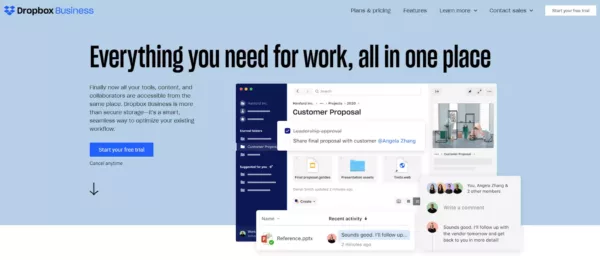 An example of how to design Shopify B2B wholesale stores – Dropbox For Business
An example of how to design Shopify B2B wholesale stores – Dropbox For Business
Dropbox also includes a FAQ section, where consumers can pick on one of four typical topics to obtain an answer in a dropdown box. It works precisely what Dropbox users would look for when visiting the Dropbox for Business website.
They additionally emphasize their brand messaging on each page by delivering a quick and straightforward “Start your free trial” call-to-action, with the added promise of helping to “Get your team in sync.”
#2 Selini NY

With moving banners, vivid photos, and Quick View options for every product, wholesale apparel provider Selini NY designed a site that appears extremely B2C—with one significant distinction.
Customers’ pricing is locked unless they log in or create an account. While this isn’t the best option for all B2B firms, it makes a lot of sense for something like fashion wholesale stores. This is especially true given Selini’s account creation process, which requires simply a tax ID number in addition to basic personal information such as name and email.
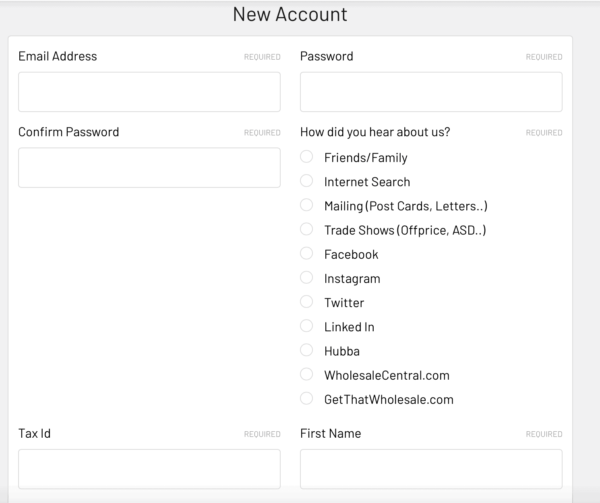
How to set up Shopify B2B wholesale stores (Source: Selini NY)
Finally, the brand makes it simple to order by not requiring a minimum order amount and offering free shipping on orders over $200.
If you require clients to sign up to see pricing or other relevant information, make the procedure quick and straightforward, and offer incentives to attract the client to register by using B2B Login/Lock & Hide Price.
Read More: Best 50+ Shopify Apps To Increase Sales
#3 BAUHAUS

BAUHAUS – design Shopify B2B wholesale store with funny elements
Back in 2014, this German home and garden company launched a B2B eCommerce platform in Sweden. They made every effort to make the ordering procedure as simple, streamlined, and easy as possible.
BAUHAUS built order, account, credit management systems, as well as an e-sign platform to service its B2B clients, who frequently made large, high-volume purchases, to move as much of the ordering and approvals process online as feasible.
However, they didn’t limit themselves to the site’s business features. They also used engaging material such as how-to videos and product content to draw people to the site and make their experience entertaining rather than just productive.
One more tip for how to set up Shopify B2B wholesale stores is don’t forget about the pleasure. Engaging content in several formats can help you keep clients on your site for extended periods, encouraging both larger and repeat orders.
Read More: Shopify Wholesale Store: 9+ Successful Website Examples
4. What Are the Future B2B Ecommerce Trends?
Previously, most orders were taken over the phone by suppliers, manufacturers, and retailers. However, these B2B buyers are increasingly sourcing through online eCommerce. Some websites also offer dropshipping, which means there is no minimum order quantity for product sourcing.
There will be little distinction between design Shopify B2B wholesale stores and B2C in the future. The B2B also has an easy-to-use website and online customer care.
- A B2B eCommerce website will offer B2C online experiences.
- More B2B vendors will connect B2B eCommerce with third-party apps.
- An increasing number of eCommerce platforms incorporate augmented reality technologies to improve the buyer experience.
- Video content will be favored to help customers understand product features.
- More payment alternatives will be made available.
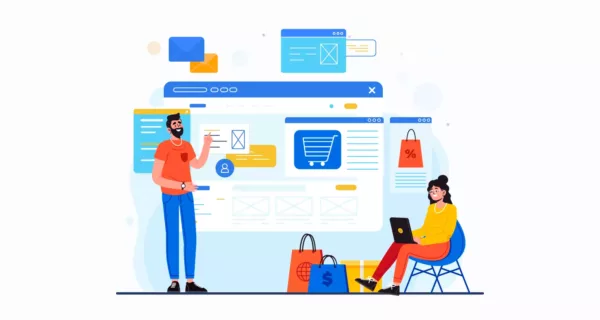
Consider adding a store locator if you are selling omnichannel with Top Best Store Locator Shopify App For Selling Omnichannel. This allows potential clients to simply visit your physical store, resulting in higher in-store sales for your business.
Conclusion
Above are four ways to design Shopify B2B wholesale stores. Each form has its advantages and disadvantages. However, if it is to choose a method that works for all businesses, a third-party application is a great way. Even if you are a small business, in the future, if you want to develop and expand your business, this way can still meet your requirements. It will be easy for you to choose the right plan for your order quantity with different prices.
Besides, third-party B2B wholesale app Shopify merit expanding stores with essential wholesale capability. Thousands of businesses have tried and tested the apps. If you encounter any problems during the setup process, you can completely contact the customer care team to minimize application conflicts and enforce customizations.
In short, you should weigh the pros and cons of each method to find the most suitable answer to the question of how to set up Shopify B2B wholesale stores.




